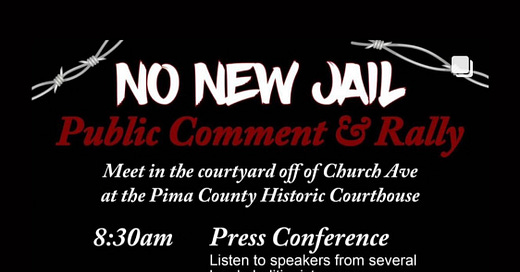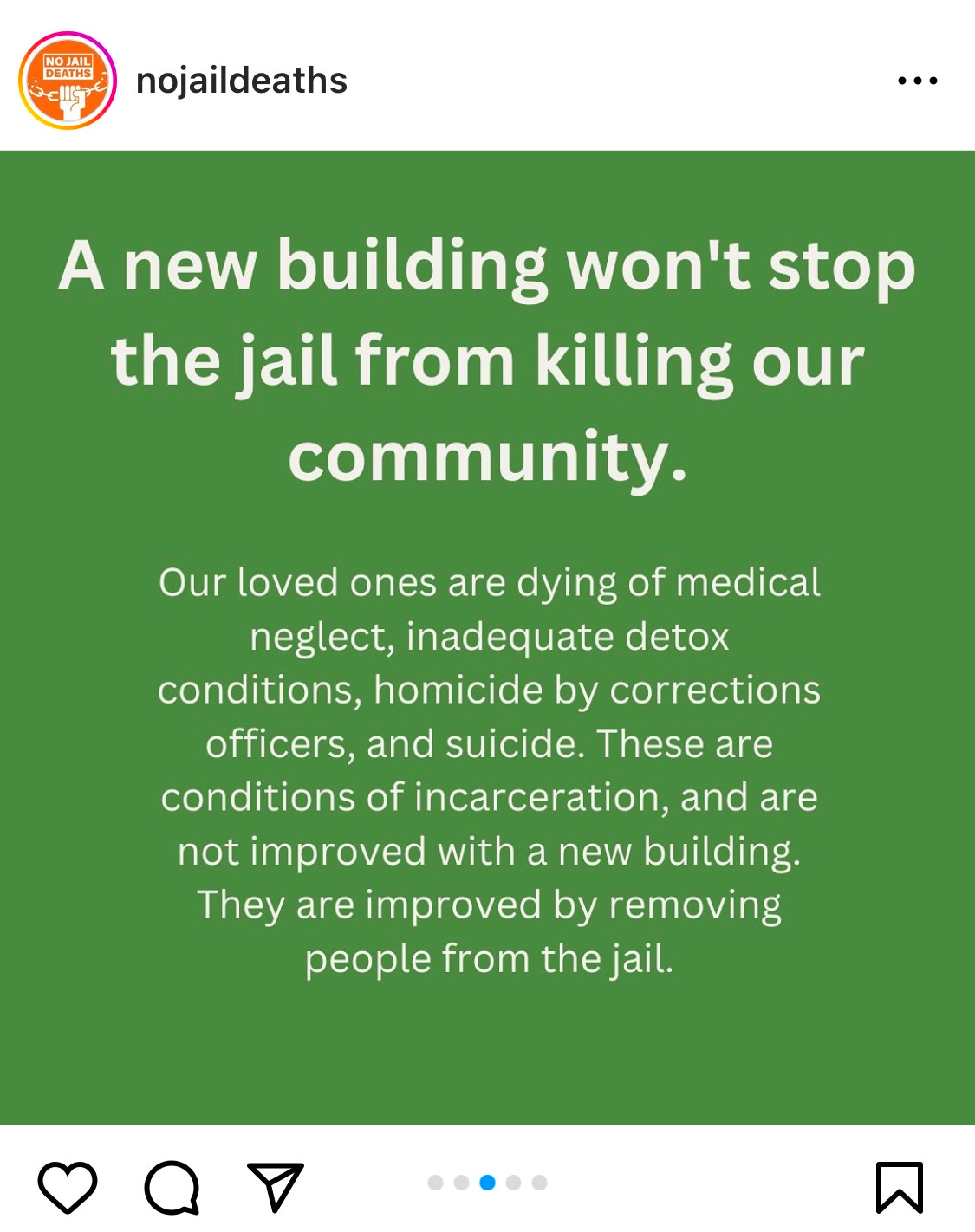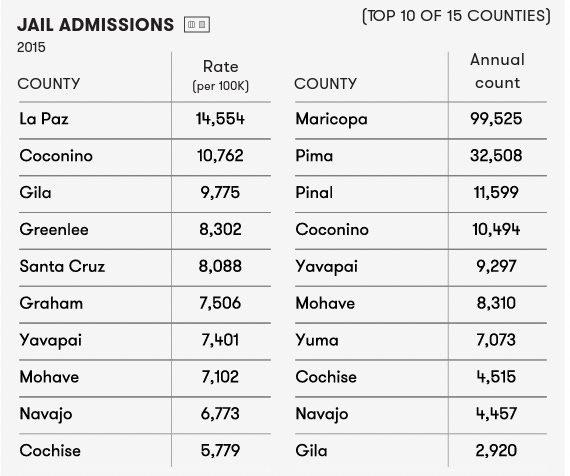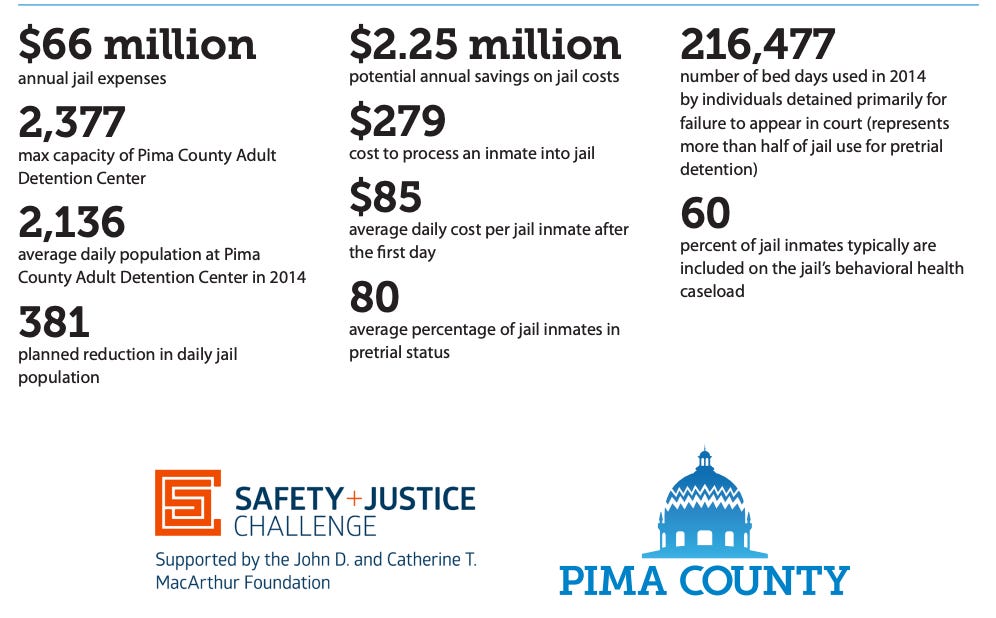The Daily Agenda: Pima County's $380 million problem
Jail review Commission to issue its findings next month ... Reform advocates plan to pack today's meeting ... TEP rates going up.
A panel of experts tapped to evaluate Pima County’s need for a new jail will meet this morning for the last time before presenting their recommendations to Pima County supervisors next month.
Their decision can’t come soon enough, as people incarcerated at the Pima County Adult Detention Center continue to die at steady and concerning rates.
County officials maintain that prisoners are receiving adequate care while in custody, but several advocacy groups are raising alarms, saying the commission hasn’t included in-custody deaths into its review.
Since the beginning of 2023, 13 people have died either in custody at the jail or shortly after being released, the Arizona Luminaria’s John Washington reported yesterday.
If you go back to the start of 2022, that number climbs to 38.
In December, Sheriff Chris Nanos asked supervisors for a new jail — which could cost taxpayers up to $380 million — citing an aging infrastructure and “full-blown crisis” involving inmate overcrowding and “critically low” support staffing.
Supervisors approved a raise for corrections officers and empaneled a Blue Ribbon Commission made up of experts in law enforcement, the justice system, construction, real estate and other fields.
The group was tasked with assessing the current condition of the jail to determine if a new facility is needed or if this one can be improved; assessing best practices and standards impacting jail operations; assessing funding options for improvements or a rebuild; and providing recommendations to the county administrator.
We created our own Blue Ribbon Commission, and after rigorous investigation, we discovered we need a lot more paid subscriptions.
The group has met monthly since March, and commissioners are scheduled to hear community feedback during today’s meeting, which begins at 9:30 a.m. at the Pima County Historic Courthouse’s Turquoise Conference Room. Public comments can also be submitted online
Some of the commission’s more pressing concerns include the jail’s medical observation and detox units operating at and over capacity at peak times and an increasing admissions to the mental health unit, but no additional space available, Pima County Administrator Jan Lesher said in a memo Tuesday.
Washington’s reporting for the Luminaria revealed that county audits show that the jail’s healthcare provider is “chronically understaffed and failing to meet contractual standards for medical care.”
Between February 2022 and April 2023, the county’s behavioral health department docked NaphCare, it’s healthcare provider, more than $3.1 million for short staffing and failing to provide contractually-obligated health services, Washington reported.
But even with the audit’s troubling findings and the assessed penalties, the county is still backing NaphCare, Washington reported.
“The County takes all allegations of substandard care seriously and investigates each and every allegation,” Paula Perrera, the behavioral health director, wrote in a July 26 email to the Luminaria. “None of the deaths were related to substandard healthcare so any such characterization is misplaced and incorrect.”
While the county might not seem concerned, the public is certainly taking notice of the jail’s reported deficiencies. More than a dozen people attended the Blue Ribbon Commission’s July 27 meeting, likely in response to social media posts by social justice advocacy groups. But their presence turned out to be a good thing, according to Lesher’s memo, as the attendees ended up participating in working group breakout sessions with commissioners.
During today’s meeting, commissioners will discuss and propose initial findings that will be presented for public input before September’s final deliberations and recommendations.
They’ll also discuss outreach efforts to gather feedback, which will include social media, press alerts, notices on the county’s webpage, newsletters and more. The public will be able to provide input via an online public comment form, which is already available on the commission’s webpage, and a survey.
But two local groups are encouraging followers to show up to the meeting and address commissioners face-to-face. Last month, No Jail Deaths and Community Care Tucson, put out the call on social media for people to attend the meeting and voice their concerns. They’re hoping for a strong turnout at today’s public input session.
Both groups posted details of a pre-meeting press conference and rally on their Instagram accounts yesterday, saying they’ll gather at 8:30 a.m. and encouraging followers to attend the meeting and “ask questions” and “demand real answers.”
The Arizona Daily Star’s Lydia Watts reported yesterday that a No Jail Deaths organizer called the scope of the commission “nebulously defined” and said that it has veered from the original intention.
Pima County isn’t alone in this issue. Jails and prisons across the state are facing scrutiny over reports of insufficient healthcare, security, nutrition, staffing and more, leading to Gov. Katie Hobbs to create in January an independent prisons oversight commission.
Both commissions will be delivering final reports next month, but let’s be realistic: Whatever these groups decide is unlikely to provide an immediate fix to an escalating problem.
It will take years to fix the current issues within the Pima County jail and even longer to build a new jail from scratch. Regardless of the commission’s recommendation, we’re still a long way from tangible solutions.
Minority rule: The minority view that people should be able to anonymously donate gobs of money to political causes and that abortion should be illegal are coming together in Arizona, the Arizona Daily Star’s Tim Steller reports. Voters have already shown they clearly want to regulate political donations and ensure abortion is legal.
“But it’s unclear if the majority will rule, in the end, or if the American political trend toward minority rule will also take hold in Arizona,” Steller writes.
Still a bad idea: The Tucson City Council scrapped a proposal to revisit the controversial waste-to-energy idea, Daniel Shailer reports for the Tucson Sentinel. City staff had prepared a grant application that included a company that specializes in burning plastic to create energy. The technology doesn’t really work, but it keeps coming up as a solution.
“We plan to stay vigilant,” said Kevin Greene, a member of Sustainable Tucson. “Waste-to-energy developers are well known for their persistence,” Shailer reports.
No more DEI at UA: Universities in Arizona are dropping their diversity, equity and inclusion statements in job applications, the Arizona Republic’s Ray Stern reports. The Goldwater Institute started pressuring the Arizona Board of Regents earlier this year, calling those statements the “new loyalty oaths.”
Ever upward: Tucson Electric Power customers will see their monthly bills go up about $11, after the Arizona Corporation Commission approved the news rates on Tuesday, the Star’s David Wichner reports. That’s less than a competing proposal that would have raised bills by about $18 a month.
We know you have a lot of bills to pay. Now you have to cover another $11 on your electric bill. Good news! You can read the Tucson Agenda for free (Or you can help us out with a paid subscription).
Pretty cool: The immersive Vincent Van Gogh exhibit opens Aug. 11 at the Oro Valley Marketplace, Cathalena Burch reports for ThisIsTucson. Dozens of projectors put you in the middle of Van Gogh’s paintings, which sounds like quite an experience.
“One of the most anticipated highlights of ‘Van Gogh: The Immersive Experience’ comes at the end, when visitors enter a large room that features a 360-degree digital show that brings 200 van Gogh masterpieces to life,” Burch writes.
$1.2 million: The amount of money Pima County supervisors had to transfer from the general fund last month to make up for the Pima County Sheriff Department’s $3.3 million shortfall for the fiscal year that just ended. The department’s budget saw notable increases in overtime, repair and maintenance costs, food and operational supplies.











It's too bad the courts and the jail seem to be unable to live up to the goals of the safety and justice challenge, grants provided through the MacArthur Foundation. One of the big goals: to reduce the size of the jail population. In 2019, the Foundation invested $3.3 million to "safely reduce the jail population by 2021." Where are we with that? The courts and jail have been working on this since at least 2015, with few tangible results. https://www.safetyandjusticechallenge.org/wp-content/uploads/2019/01/Pima-County-SJC-Fact-Sheet-2019.docx.pdf
Jail story could have included Dr. Ravi Shah's recent appointment as medical director. He's high profile in the community and perhaps has a role in how inmate health will be addressed.